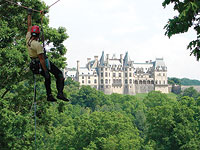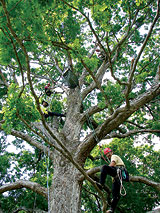
photo Anne Sherrill
|
Bill Hascher spends a lot of his time in trees. It’s what he does.
On a recent spring day, Hascher ascends a rope slung over a long, knobby branch of a century-old white oak. The limb is about 50 feet high — midway to the tree’s top. Hascher, who is 37, works as an arborist at Biltmore Estate and spends most of his time preserving, pruning and removing trees to keep visitors safe from the dangers of decayed limbs and falling trees. This tree, however, which commands a hill in south Asheville, is sound and sturdy and Hasher has no intentions of pruning it. He is climbing it to, well … just to climb it.
For a kid, climbing trees is as routine as splashing in puddles, playing with dolls, or playing hide-and-go-seek. As adults, though, climbing a tree for pure pleasure falls into the category of activities most of us have given up. But if it’s so much fun, why leave it behind?
A few adults, including Hascher, haven’t. “It’s nice to be out there without all the tools, away from the hustle and bustle,” he explains.
 |
Hascher has been climbing trees most of his life and is an advocate of what’s come to be known as “recreational tree climbing.” In the last decade or so, the sport has evolved to include a set of ethics, a variety of specialized safety techniques and a cadre of devoted followers. While public climbing at Biltmore Estate is prohibited, you need not own a country estate to get started with the sport. All you need, in fact, is a tree in your own back yard.
Tree climbing has been around for eons, but as an organized sport it developed less than three decades ago. The guru of recreational tree climbing is a guy named Peter Jenkins, who’s been preaching the gospel to a growing congregation of tree fanatics. Jenkins is the founder of Tree Climbers International (www.treeclimbing.com), the sport’s Atlanta-based organizing body.
You might ask, though, why climbing trees needs to be an organized sport? Why not just reach for the lowest branch and go? Well, for one, climbing trees by the seat of your pants, as it were, can be an iffy stunt. As Hascher explains, “One thing the sport has done is make climbing trees safer.”
To set his rope in the oak, Hascher tosses a fist-size bag of shot attached to a long section of thin cord over a stout branch. He uses this to pull an arborist rope the diameter of one’s thumb over the branch. After tying the rope into his harness, he ascends the line using a sliding, self-tightening knot called a Blake’s hitch. Rather than using his arms to climb the rope, Hascher slips his feet into a loop of rope at his waist and steps up, sliding the hitch with him as he goes. Once he’s made it to the tree’s canopy, he can fix another rope, explore laterally on safety tethers, or just hang out for a while and take in the view.
Climbing trees without ropes a la John Muir has obvious risks, and fear of falling is one reason calculating adults usually give it up. After all, the consequence of a blunder is near-certain injury. Rope-assisted tree climbing captures a similar sensation without the unpleasant shadow of death hovering near.
“What attracted me as a child to climbing trees still attracts me as an adult,” says Genevieve Summers, owner of the Georgia-based Dances with Trees. “You can access the same pleasure but with a deeper connection.”
And promoting a deeper attachment to trees is exactly what tree scalers like Summers and Hascher aim to achieve. In fact, their passion is less about the adrenaline of risk-taking than it is about tree time: finding a sweet spot in the lofty world.
What most tree climbers have in common is a soundly rooted affection for trees and nature. And spending time high in the leaves affords a totally different perspective on nature, allowing you to see things you could never observe from the sidewalk.
“Every time I’m in a tree I find something special and unique,” says Tobe Sherrill, a climber since 1990 and operator of Sherrill Tree Climbing Supply in Greensboro, a commercial and recreational gear source.
Not everyone shares Sherrill’s and other tree climbers’ enthusiasm for the sport. The city of Asheville, for example, has no ordinance associated with recreational tree climbing but discourages the pastime in public parks and green spaces due to liability and tree-damage concerns. And some critics of the sport point to the impact that comes from climbers intruding on fragile ecosystems typically free of humans.
Climbers acknowledge their critics’ unease about the sport. But besides promoting personal safety, says Sherrill, enthusiasts encourage such tree-friendly techniques as using friction-saving devices, knowing where and when to climb, and avoiding delicate habitats and vegetation.
Many in the blossoming sport believe the positive impact of playing in trees may, on balance, be worth it.
“My hope is that more people will look up and have a deeper connection with trees and nature,” says Sherrill. “I think that’s a good thing.”
[West Asheville resident Jack Igelman can be reached at jigelman@att.net.]



Before you comment
The comments section is here to provide a platform for civil dialogue on the issues we face together as a local community. Xpress is committed to offering this platform for all voices, but when the tone of the discussion gets nasty or strays off topic, we believe many people choose not to participate. Xpress editors are determined to moderate comments to ensure a constructive interchange is maintained. All comments judged not to be in keeping with the spirit of civil discourse will be removed and repeat violators will be banned. See here for our terms of service. Thank you for being part of this effort to promote respectful discussion.